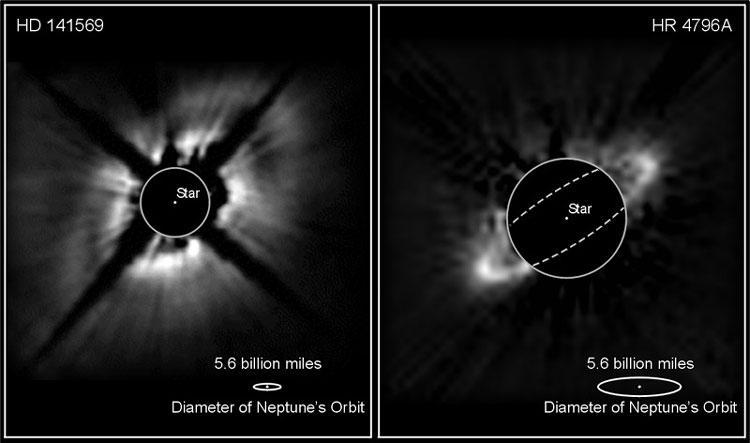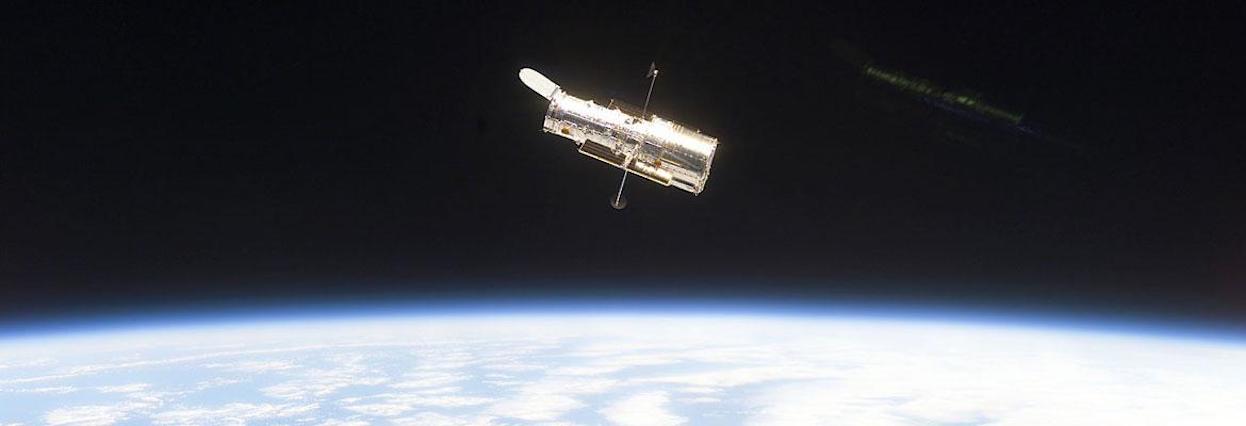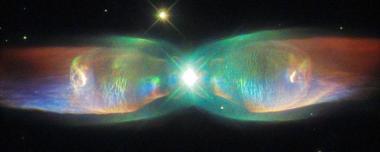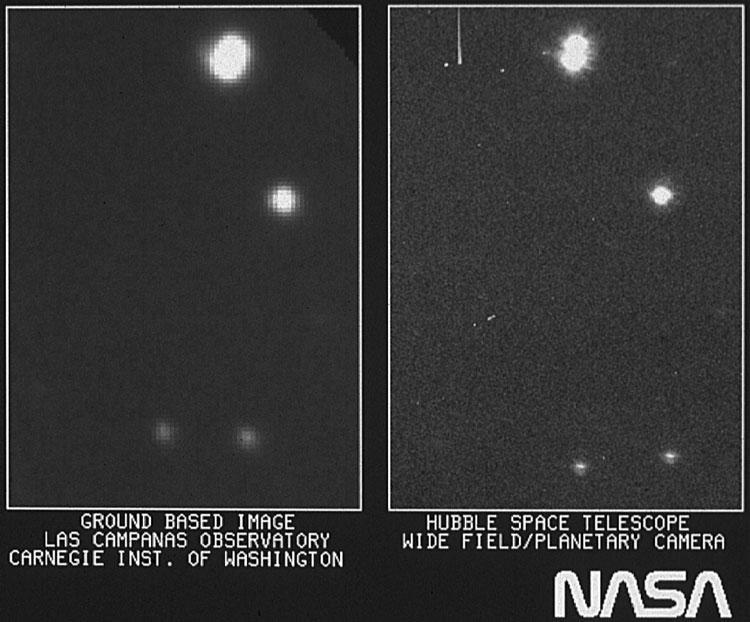Researchers from the UA and across the globe have used Hubble to peer into distant galaxies, and to better understand the history and the future of our expanding universe. Here, we offer information on Hubble, its history, and how UA astronomers have used it to create new astronomical knowledge.
Hubble Space Telescope Facts
-
Hubble Space Telescope is about the size of a large school bus.
-
It weighs 24,500 pounds. That’s just under two adult male African bush elephants.
-
Hubble gathers energy from the sun using two 25-foot solar panels. It requires much less power than one might think, averaging 2,100 watts of power usage. A hair dryer requires about 1,800 watts.
-
Hubble orbits the Earth at a cruising speed of 17,000 miles per hour, and takes 15 minutes to rotate 90 degrees.
-
Hubble has observed locations more than 13.4 billion light years away, meaning it has seen light that existed in the universe 13.4 billion years ago.
-
Astronomers using Hubble data have published more than 13,000 journal articles, making it one of the most productive scientific instruments ever built.
University of Arizona Discoveries on Hubble
The University of Arizona has contributed to innumerable studies in space sciences, and its researchers have been using NASA’s Hubble Space Telescope to do so for decades. Each year since 1990, NASA has funded the research efforts of a select group of astronomers through its prestigious Hubble Fellowship. Since then, nearly 20 University of Arizona researchers have been named Hubble fellows. Below are just some of the discoveries that UA astronomers have made using Hubble.
-
1994: A team of astronomers led by Peter Smith, professor emeritus at the UA, took the world’s first images of Saturn’s moon, Titan. At the time, scientists suspected that Titan’s surface was covered with a global ethane-methane ocean. The images revealed that, in fact, there was at least some solid surface on Titan.
-
1996: A team that included Erich Karkoschka, UA Lunar and Planetary Lab senior staff scientist, captured images of Uranus’s atmosphere, observing clear and hazy layers created by a mixture of gases. Using infrared filters, Hubble captured detailed features of three layers of the planet’s atmosphere.
-
1996: Through research done by then UA senior staff scientist Steve Larson and others, Hubble captured a rare view of Saturn’s rings, seen just after the sun had set below the ring plane. This perspective is unusual because the Earth is slightly above Saturn’s rings and the Sun is below them, so normally we see the rings fully illuminated by the Sun.
-
1999: Hubble completed an eight-year effort to measure the expanding universe, co-led by Robert Kennicutt, then UA professor of astronomy. The team found that a galaxy appears to be moving 160 thousand miles per hour faster for every 3.3 light-years away from Earth. The team used the Hubble telescope to observe 18 galaxies out to 65 million light-years.
hs-1999-03-a-web_print.jpg

-
1999: The Hubble Space Telescope gave astronomers their first views of a dust ring around a star and a dark gap dividing an immense dust disk around another star. UA astronomer for Steward Observatory Glenn Schneider was on the team that captured these images.
-
2006: A team led by then UA astronomer Doug Clowe and including Steward Observatory astronomer Dennis Zaritsky found direct proof of dark matter using Hubble Space Telescope.
-
2007: Hubble took images of asteroids that helped astronomers prepare for a spacecraft visit. The images of Vesta and Ceres showed two of the most massive asteroids in the asteroid belt, a region between Mars and Jupiter and helped astronomers plan for the Dawn spacecraft’s tour of these asteroids. UA astronomer Mark Sykes was on the team that captures the images.
-
2011: UA Lunar and Planetary Lab Professor Adam Showman contributed to Hubble’s one millionth scientific observation, an eclipsing extrasolar planet and host star.
Hubble Space Telescope History
-
The Hubble Space Telescope is named after Edwin P. Hubble, the American astronomer who confirmed that the universe is expanding, which provides the foundation for the Big Bang theory.
-
In the 1920s, Edwin Hubble used the 100-inch telescope at Mt. Wilson Observatory in Los Angeles—then the largest telescope in the world—to discover that the Andromeda is its own galaxy. It was previously believed that the Andromeda Galaxy, and others like it, were “spiral nebulas” within the Milky Way.
-
Although the HST is named after Hubble, its history begins with another man: Lyman Spitzer. In 1946, Spitzer was a professor and researcher at Yale University. He wrote a paper titled “Astronomical Advantages of an Extra-Terrestrial Observatory,” wherein he argues that a space-based telescope could take clearer photos by evading Earth’s atmosphere and could detect electromagnetic frequencies that ground-based telescopes cannot. Decades later, in the 1970s, Spitzer helped lead NASA’s lobbying efforts for Hubble.
-
Don’t feel bad for Lyman Spitzer though. He eventually got his name on a telescope. NASA’s Spitzer Space Telescope launched in 2003.
-
The HST launched in April 1990 from the space shuttle Discovery, and took its first image of a star cluster 1,300 light years away, NGC 352, a little over a month later. The image is notoriously unremarkable, for a couple of reasons.
-
The first: Every telescope undergoes a “first light” test. When, for the first time ever, light travels through the telescopes optics and hits its detectors, the telescope has experienced its “first light.” First light images tend to be unimpressive, meant not for the public, but simply a test. In the case of the Hubble Space Telescope, the press was invited to watch as Hubble opened its eyes for the first time, and, as the story goes, they weren’t impressed. One is said to have asked, “Is that the way it’s supposed to look?”
-
Hubble was a $2.5 billion scientific venture, and its first photo was only 50% sharper than what an already existing ground-based telescope in Chile could take.
-
Hubble engineers scrambled to improve the image quality, but quickly discovered that Hubble’s major defect was in its main mirror.
-
Three years later, engineers were able to fully correct Hubble’s blurry eyesight. The mirror had a spherical aberration caused by a manufacturing error. So in late 1993, NASA mounted a repair mission. A crew of seven astronauts flew to Hubble and spent five days installing two new cameras.
-
A repair mission of this sort would not be possible on any other space-based telescope. Hubble was the first one that NASA designed to be serviced and repaired in space.
-
The first new images from Hubble reached Earth that same December. In over 25 years of operation, Hubble has taken some of the world’s most stunning images of the vast, incomprehensibly ancient universe.




